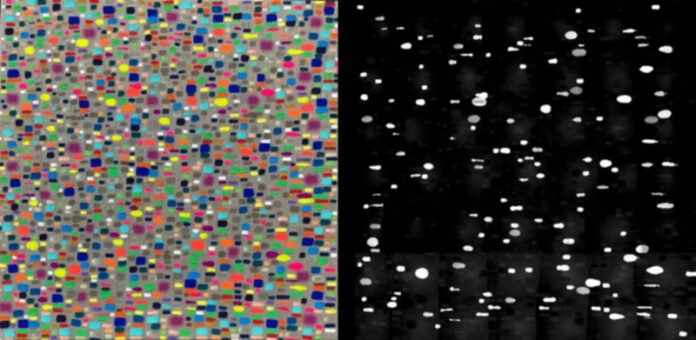
MSK nanotechnology researcher Daniel Heller recently worked with an artist to create nanotube-based paints that can be used to test for cancer and diabetes — and to make a new form of visual art.
“When I first saw Joseph’s work in an art gallery, I didn’t know how to approach it,” says Dr. Heller, who is also an associate professor at the Weill Cornell Graduate School of Medical Sciences. “But when he spoke about how he carefully chooses and combines materials to make new paints with new properties, I realized that his process is not so different from that of a materials scientist or engineer.”
Dr. Heller’s lab uses carbon nanotubes in diagnostic sensors. The tiny tubes are so small that millions of them could fit on the head of a pin. The tubes absorb and emit harmless infrared light that is visible with special cameras, but not to the eye. Generally, Dr. Heller uses these materials to create tests that can help diagnose diseases. Together with Mr. Cohen, he developed a paint that is invisible to the eye but lights up through an infrared camera.
“The works bring together scientists, artists, and members of the public where everyone learns something.”
Daniel A. Heller
Molecular Pharmacologist
Dr. Heller’s lab may have first developed the paints with Mr. Cohen to show people how nanotubes work, but eventually the scientists found them useful for cancer research. Januka Budhathoki-Uprety, a research scholar in the Heller lab, was working on a new test for microalbuminuria. This condition is an important early marker for several cancers, as well as for diabetes and high blood pressure. Microalbuminuria occurs when the kidneys leak small amounts of the protein albumin into the urine.
Although it is possible to detect microalbuminuria, the conventional method requires antibodies, which need to be stored carefully. Samples must then be sent to a specialized lab. The researchers wanted a test that would produce results faster and be useful in places far from a diagnostic lab.
Dr. Budhathoki-Uprety was initially using the carbon nanotubes to detect microalbuminuria in a test tube. However, she and Dr. Heller realized that, by incorporating the nanotubes into Mr. Cohen’s paints, they could build a much more versatile sensor.
“When we made the nanosensors into a paint, we found that they worked perfectly to detect albumin and could be painted on any surface,” Dr. Budhathoki-Uprety says.
“We initially thought that, in working with an artist, we would make art to shed a little light on our science for the public,” Dr. Heller says, “but the collaboration actually taught us something that could help us shine a light on cancer.”
Joseph Cohen and Dr. Heller’s work exemplifies the potential of cross-disciplinary collaboration. What began as a collaboration intended to use art as a means of explaining complex medical issues to the public, resulted in a ground-breaking medical innovation. Before this project, the conventional method of detecting microalbuminuria was possible but was time consuming. The search for a faster method initially only involved medical professionals. However, exploring the possibility of a faster test when utilizing Cohen’s paint resulted in massive progress.
Highlighting the benefits of cross-disciplinary research, this article is an important reference for addressing the issues surrounding hypertension from a broad scope. Monitoring blood pressure is a complex, multi-faceted issue that traverses many areas, from politics, to technology, to medicine, to art. However despite the intersections, there is not enough collaboration between some of these sectors. Looking at the problem from only one of these lenses minimizes a concept’s potential and breadth. To design a solution that addresses blood pressure management, factors such as socio-economic levels, healthcare, education, and environment cannot be overlooked.



